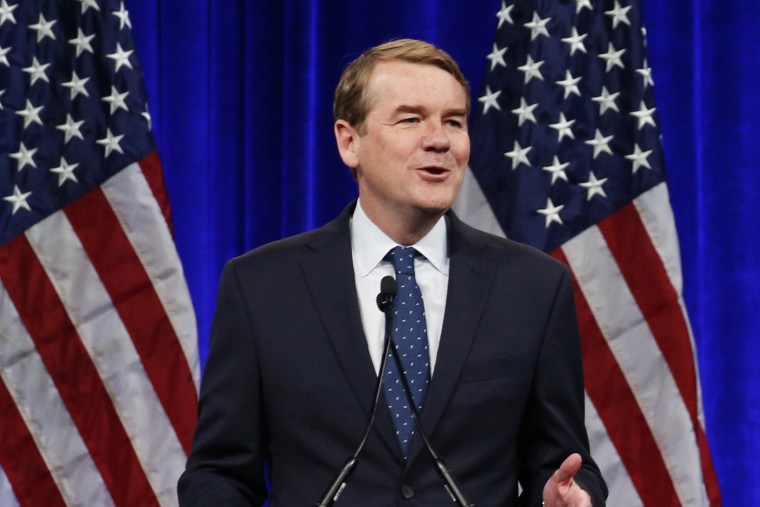With the control of the Senate on the line and Election Day nearing, Republican and Democratic groups and candidates are starting to pump greater sums of cash into key battleground states.
The battleground map has been clear for months, but tracking changes in ad spending is one way to see what races are gaining or losing steam.
The NBC News Political Unit compared ad spending from the ad tracking firm AdImpact in two, two-week periods—from Sept. 5 through Sept. 18, and then from Sept. 19 through Oct. 2—to see which races are heating up.
Here’s a look at the races with the highest increases in ad spending over the two periods analyzed, only including races rated competitive by The Cook Political Report with Amy Walter.
Colorado Senate: 229% increase
The Colorado Senate race between Democratic Sen. Michael Bennet and outsider challenger Joe O’Dea has seen one of the greatest increases in Senate advertising spending since Labor Day. According to AdImpact, outside spending by Democrat and Republican groups has tripled in the past two weeks for both sides, even as candidate spending has stayed flat or, in the case of O’Dea, dropped.
Two outside groups for Bennet, 53 Peaks and the Giffords PAC, both recently started $2.5 million ad buys attacking O’Dea, while also trying to link him to the Republicans at large.
O’Dea is getting help from the American Policy Fund, an outside group that helped O’Dea win his primary. According to AdImpact, the group has spent over $1 million in ads just over the past week, running spots that attack Bennet for inflation and for being a Washington insider.
Utah Senate: 71% increase
In Utah, independent candidate Evan McMullin has started spending more in his race against Republican Sen. Mike Lee. According to AdImpact, spending for McMullin has increased by 93 percent over the past month. McMullin is buying more of his own ad time, and getting help from the Put Utah First independent PAC.
Republicans have increased their spending by 65 percent over the same time period, with the main boost coming from a series of ad buys by Club for Growth Action, the political action arm of the conservative Club for Growth. McMullin charges that some of the ads are distorting his past statements and has sued the Club.
Lee has an advantage in ad spending, with the total amount of support he’s gotten from outside groups topping $2.7 million, while McMullin only has $1.6 million.
Nevada Senate: 32% increase
Nevada is one of the closest contested Senate races in the nation, as Democratic Sen. Catherine Cortez Masto fights to hold onto her seat against Trump-backed Republican challenger Adam Laxalt. Overall ad spending has increased 32 percent since Labor Day, according to AdImpact. The greatest increase is coming from the Republican side, where outside groups have moved in force to support Laxalt who has struggled with his own fundraising.
Just in the past week, outside groups such as Club for Growth Action and the Senate Leadership Fund had spent over $3.8 million supporting Laxalt. In the same period, Laxalt had spent just over $850,000 on his own or in combined ads with the National Republican Senatorial Committee. Since Labor Day, Republican spending has increased by 48 percent, the largest increase of Republican spending in any race deemed Toss Up by the Cook Political Report.
On the other hand, Cortez Masto is spending a much greater amount on her own ads, topping $1.6 million in bought time just in the past week. She’s getting help from the Senate Majority PAC, but not nearly as much as Laxalt is getting from outside Republican aligned groups.
Cortez Masto's strong fundraising is compounded by the fact that candidates get cheaper advertising rates than outside groups, allowing Democrats to stretch that money further.
North Carolina Senate: 29% increase
Between the two periods analyzed there’s been a 29 percent increase in ad spending, with new money coming into the race in equal amounts from the Democratic and Republican sides.
Since Labor Day, Republicans have seen a 30 percent increase in ad spending, with the lion’s share of the increase coming from the support of the Senate Leadership Fund, who has been carrying the weight of the ad spending. In the past two weeks alone, the Senate Leadership Fund has spent over $6.4 million supporting Ted Budd.
Beasley has not benefited from the same kind of outside support. Even though Democratic ad spending in the race has increased 27 percent, Beasley has bought the majority of that ad time and has gotten much less support from national groups than Budd.
That spending comes as some Democratic politicians call for the party to invest more in a state where they have lost to nail biters many times before.
Wisconsin Senate: 20% increase
In Wisconsin, the Senate race between Republican Sen. Ron Johnson and Democratic challenger Mandela Barnes is attracting big money from both Republicans and Democrats. Ad spending has increased by 20 percent over the two periods analyzed, with Republican spending increasing by 12 percent and Democratic spending by 33.
On the Democratic side, the largest increases in spending are coming from Barnes himself, who had bought nearly $2 million in ads in the week ending October 2, according to AdImpact. Barnes is also getting a boost from the Senate Majority PAC, which bought $1.8 million in ad time in the same one-week time period.
On the Republican side, the majority of spending is coming from McConnell’s Senate Leadership Fund, which spent over $2.4 million on ads attacking Barnes over the same time period. While Johnson is buying some of his own ad time, the majority of the recent spend for the Republican candidate—as is the case in many races throughout the country—is coming from outside groups like Senate Leadership Fund.
In Wisconsin, both national Democrats and Republicans are making deep investments. Any move out of this battleground by either side could be a major indicator about the state of the race.
